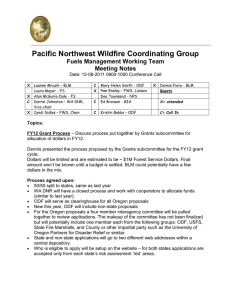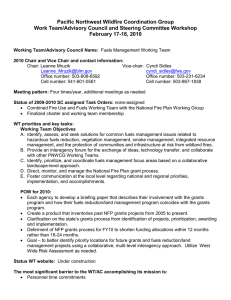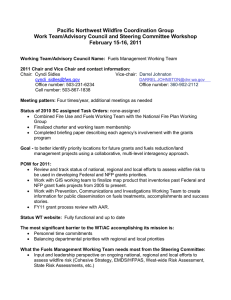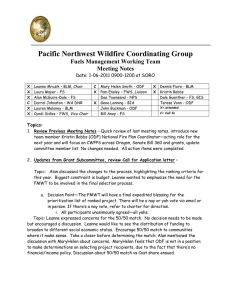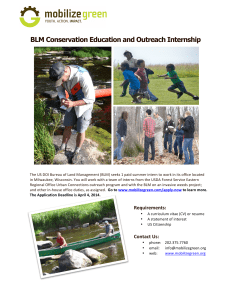Pacific Northwest Wildfire Coordinating Group Fuels Management Working Team Meeting Notes
advertisement
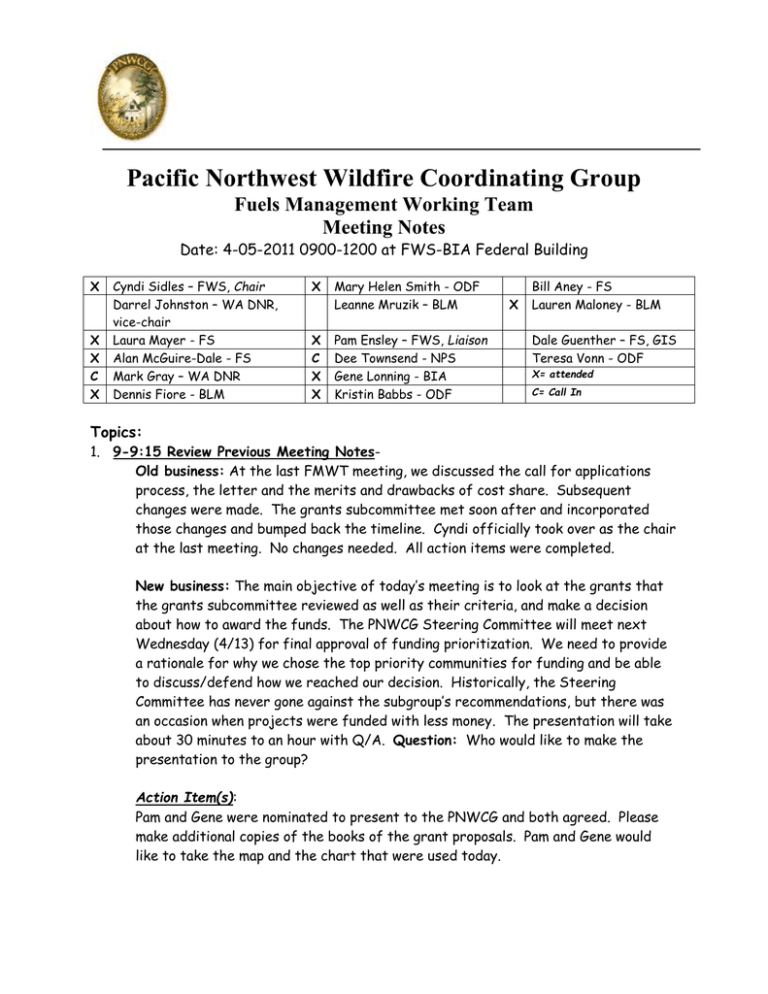
Pacific Northwest Wildfire Coordinating Group Fuels Management Working Team Meeting Notes Date: 4-05-2011 0900-1200 at FWS-BIA Federal Building X X X C X Cyndi Sidles – FWS, Chair Darrel Johnston – WA DNR, vice-chair Laura Mayer - FS Alan McGuire-Dale - FS Mark Gray – WA DNR Dennis Fiore - BLM X X C X X Mary Helen Smith - ODF Leanne Mruzik – BLM Pam Ensley – FWS, Liaison Dee Townsend - NPS Gene Lonning - BIA Kristin Babbs - ODF X Bill Aney - FS Lauren Maloney - BLM Dale Guenther – FS, GIS Teresa Vonn - ODF X= attended C= Call In Topics: 1. 9-9:15 Review Previous Meeting NotesOld business: At the last FMWT meeting, we discussed the call for applications process, the letter and the merits and drawbacks of cost share. Subsequent changes were made. The grants subcommittee met soon after and incorporated those changes and bumped back the timeline. Cyndi officially took over as the chair at the last meeting. No changes needed. All action items were completed. New business: The main objective of today’s meeting is to look at the grants that the grants subcommittee reviewed as well as their criteria, and make a decision about how to award the funds. The PNWCG Steering Committee will meet next Wednesday (4/13) for final approval of funding prioritization. We need to provide a rationale for why we chose the top priority communities for funding and be able to discuss/defend how we reached our decision. Historically, the Steering Committee has never gone against the subgroup’s recommendations, but there was an occasion when projects were funded with less money. The presentation will take about 30 minutes to an hour with Q/A. Question: Who would like to make the presentation to the group? Action Item(s): Pam and Gene were nominated to present to the PNWCG and both agreed. Please make additional copies of the books of the grant proposals. Pam and Gene would like to take the map and the chart that were used today. 2 2. 9:15-9:30 Review PNWCG Steering Committee annual workshop meeting minutes held Feb 15 and 16Summary: FMWT presented their program of work and FY10 accomplishments to Steering Committee. Pam reported that there is not a lot of effort/support behind tasking the FMWT with another Cohesive Fuels Management Strategy for the PNW. It does not does not have a lot of traction, in that it would only add to even more confusion with so many other initiatives going on right now. For the moment, there is no light at the end of the tunnel and no good answers but there is understanding about what we are going through and what needs to take priority. The West Wide Risk Assessment (WWRA) will be done in 9 months. It includes 17 western states, defines high, medium and low priorities, and provides a crosswalk from the state’s work to the WWRA. Question: Will the WWRA be further broken down into smaller regions within the western region? PNWCG has asked our committee for a map through 2010, to show progress on fuels projects/ treatments (community, state and federal) over a 5 year period in WA and OR. Discussion ensued: Do the maps need to be updated? GIS work has been done for CA grants. Dennis says we have one from 2007 but it is not current and is lacking BLM and Park Service projects. Cyndi asked Dale about the map and what we could do to help get it done-- we sent all fuels projects to him (had some gaps) in the past. BIA is working on polygons. Mark Grupe was doing polygon data for NPS but not sure how far back that goes. A map was generated from NFPORS including prescribed fire. NPS worked with fuels specialists at each park to gather info as well as the mechanical side. Action Item(s): Cindy will try to get Dale to the next meeting and see what he needs from us to get one generated. Action Item(s): Gene is retiring September 30!!! We need to celebrate his retirement at the next meeting and have lunch together afterward! 3. 9:30-11:00 Review and verify Grants Subcommittee community assistance grants project prioritization– Dennis posted and presented a map of high risk areas in Oregon and high priority CWPP areas in Washington (the states are a little different in how they identified their risk areas). The triangles on the map showed proposed project locations adjacent to federal lands. Dennis also posted and presented a matrix that listed the projects prioritized by the states. Dennis then provided a power point presentation with four potential funding scenarios (attachment 1, below). The FMWT was tasked with 3 deciding on a funding scenario to take forward to the Steering Committee for final approval. Though no appropriations bill has passed to date, funding rumor is $1.6 to $1.8 million- all Forest Service money. There is a potential for up to $75,000 in BLM funding, BLM dollars were not included in discussions. Nineteen proposals were received, 7 Washington, 8 Oregon and 4 non-state Oregon entities (attachment 2, below). All proposals met required criteria. WDNR worked with communities within the footprint of their resource strategy. ODF required that projects be listed as a high Community at Risk and that they pick their high priority projects in their CWPP. The FMWT discussed the pros and cons of each strategy and came to the conclusion: If $1.6 million comes through, then the states will split the money 50/50. $800K will go to WA (that’s what they were planning on anyhow) and $800K will go to OR. To incorporate Oregon’s non-state applications, $400K will go to the counties ($200K to Josephine and $200K to Deschutes and those entities will decide which of their projects they will fund). The other $400K will go to the top two priorities on the state list. If final funding is $1.8 million, the additional $200K will go to Oregon to fund the third state priority. Should funding exceed 1.8M or drop below 1.6M, the states and Forest Service will reconvene to deliberate funding. This decision will be presented to the Steering Committee next week. The team feels that this is a good rationale and basis for organizing the money for the states. Though not required, several of the projects tie to Collaborative Forestlands Restoration Areas. If additional funding became available, the CFLRA could help shake out other priorities. Question: Who writes and sends out the letters? First, we need to see if we get the funding. Action Item(s): Dennis and Alan will call the states and counties after the PNWCG meeting and let them know that they have been tentatively selected. 4. 11:00 – 11:45 Solidify Program of Work for 2011, make assignments if needed: We have another meeting on April 28th. Should we keep it? Leanne can’t be there and we want to have it before fire season. We briefly reviewed the program list: FMWT Program of Work Items: Review and track status of national, regional and local efforts to assess wildfire risk to be used in developing Federal and NFP grants priorities. Work with GIS working team to finalize map product that inventories past Federal and NFP grant fuels projects from 2005 to present. 4 Work with Prevention, Communications and Investigations Working Team to create information for public dissemination on fuels treatments, accomplishments and success stories. Figure out what media type would be best for that effort. FY11 grant process review with AAR. (After-Action Review). This will likely be its own meeting. Action Item(s): We will keep the 28th meeting for now. Cyndi will send out a doodle poll for an alternative date and will send the ‘Program of work’ list out to the group. At the next meeting we should identify what we really want for mapping criteria and get a focus for the plan of work, and then include Dale. Laura will send data national standards to Cyndi. We will try to get a room at the new Coordination Center. Otherwise we can do it here. Dates to Remember: April 28th, 2011 FMWT Meeting. Hold this for now. Time and location still to be announced. October 25th, 2011 FMWT Meeting. Time and location still to be announced. Note Taker for Next Meeting: Gene offered for the last time. Thanks, Gene! Attachment 1: FY 2011 Community Assistance Project Proposal Funding Strategy Summary: This year we received 19 proposals, 11 from Oregon and 8 from Washington, majority being sponsored by the States, with the exception of 3, which are Non-State entities. All proposals are compliant and meet the requirements as outlined in the application. Due to budgetary constraints, the challenge for awarding monies is determining the distribution between the two States. Listed below are several possible scenarios describing the distribution. 5 Scenario A: Fund all 19 Projects. Adjust the funding cap to accommodate all the projects. Pros: 1) All projects get funding, including low priority and everyone’s happy. Cons: 1) Partial funding my lead to incomplete projects or requires reapplication the following year. 2) Lower project receive funding but may not be the best allocation of funds. Scenario B: Allocate 50/50 split to each State. The FMWT will validate or modify WDNR’s and OR’s priorities, including the 3 non-state entities. Parcel half of the total amount of funding to each State and allow States to determine distribution of monies to projects. Pros: 1) Better tracking of unfunded projects and which ones should be moved into next grant cycle. 2) States are applicants and know project best and provide insight to which projects to be funded and moved to next cycle. Cons: 1) No input from Fed Agencies on how and where funding is going. 2) Less opportunity for Agencies to participate and may not match Fed priorities. Scenario C: Fund all 3 Non-State projects and allocate remaining funding as 50/50 split between States. Pros: 1) Encourage other communities to become involved and take ownership (cohesive strategy). Cons: 1) Less State project funded, more projects without ODF/WADNR applicants can mean more NEPA work for Feds. Scenario D: Wildcard. Group’s creates its own scenario. EXAMPLE: Every applicant (State or Non-State) competes for funding available in one pool. Pros: 1) Limited funds get to have true collaborative projects that area high priority for all Agencies that may meet cohesive strategy down the road. 2) Feds more likely to make sure Federal monies that are allocated and implemented adjacent to Fed lands concur with fuels projects on Federal l lands. 3) Buy in of projects at all levels Cons: 1) Requires more involvement at all levels. 2) Development of new criteria and selection process by the FMWT. 6 3) May require more Feds to be involved with more NEPA. Attachment 2: Attachment 3: FMWT Prioritization Process At-a-Glance Applications received: WA: 8 ranked grants for $1.6 Million OR: 7 ranked grants for $1.4 Million OR Non-State: 4 grants for $0.8 Million Total of $3.8 Million in grant proposals 7 Potential Funding: USFS: $1.6 to 1.8 Million BLM: Potentially ~$75K, currently an unknown: disregarded this funding for the selection process for the time being Selected Alternative D (wildcard scenario) for the selection of proposals for funding: 1. Split the funding level of $1.6 Million evenly between WA & OR 2. Split as follows: a. WA $800K – recommend funding the first 4 ranked priorities b. OR Non-State - $400K i. $200K to Deschutes Co. – 1st priority ii. $200K to Josephine Co. – CWPP group to determine priorities c. OR $400K – recommend funding the first 2 ranked priorities 3. If FS receives funding of $1.8 Million, that additional $200K will go to OR – recommend funding for third ranked priority. 4. If the FS gets either more or less than the $1.6 – 1.8 Million, then the following recommendation would apply: a. Oregon Non-State applicants funding will remain $400K b. States of OR & WA and the Forest Service will reconvene to determine how to adjust the difference in funding, either above or below the projected funding level.
